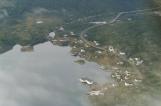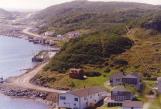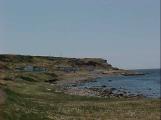14
Located on the eastern shore of the Great Northern Peninsula, Conche is a fishing community on the sheltered south side of the Conche Peninsula. It was speculated that the name Conche is possibly derived from the French family name Chibon or Chiban or from an abbey in Normandy named Conches. Local tradition maintains that the settlement is named for the conch, a shellfish in the area, or from the shape of the peninsula which resembles the shellfish. For centuries, Conche was used as a seasonal French fishing station. From 1713 to 1904 Conche came within the boundaries of the French Shore and it was a major site of the French Shore fishing activities. The last French fishing rooms were abandoned in 1867 but the French fishermen continued to frequent the area until the French Shore was abolished in 1904.16
A small fishing village south of St. Anthony on the east side of the Great Northern Peninsula, Croque, or Croc, as it was once known by the French, is situated at Épine Cadoret inlet on the northwest shore of the bay known as Croque Harbour. Croque Harbour is long, narrow and curving towards its head, in a shape somewhat like a hook. The settlement may take its name from this physical characteristic. "Croc" means boat hook in French. With easy access and an almost completely landed-locked harbour, Croque was one of the principal fishing stations on the French Shore. From the 1600's to the 1800's, the French came to Croque for the summer fishing season. In 1640, Croque was pronounced the place of registration for all ships fishing the Petit Nord. Once the fishing season was over, they sailed back to the European markets and their homes in France.18
Forteau was a service centre for the Labrador Straits Fishery. When translated, the community's name means "Strong Water" perhaps because of the strong tides in the area. There has been evidence that the Maritime Archaic Indians had settled here in 5560 B.C. Later, the Basque used this harbour as a whaling station. In 1757, the French built a garrison in the area. Forteau was used by Europeans because of the good fishing grounds and the seals' migratory path which passed through the area.20
From the mid 17th to the mid 19th century, Grandois and St. Julien's were known as separate communities and were used extensively as migratory fishing stations by French fishermen out of the Breton Port of St. Malo. Together along with neighboring St. Julien's Island, the three communities accounted for 15% of French activity on the shore.The communities were used as French summer fishing stations as late as 1848. However, by 1874 the French had moved their operations further north, abandoning the communities.
22
Located near the northern tip of the Great Northern Peninsula, St. Lunaire-Griquet is a municipality about 20 km northeast of St. Anthony. The first English settlers at St. Lunaire-Griquet were likely guardians, who oversaw the French fishing premises during the winter months and were in return permitted to fish on grounds reserved for the French. By 1872, there was no longer a French presence in the area.24
Located near the Quebec border in Western Labrador, on the shores of Little Wabush Lake, Labrador City is a mining community of approximately 8600 people. The Labrador City area, also known as the "Iron Ore Capital of Canada", was first mapped in 1894 by Albert Peter Low, a Canadian government geologist. Although a body of iron ore was discovered in 1936, it was not until 1958 that development of the mining operations in the area began. In 1959, construction of a town site commenced and by 1960, 1200 people lived in the area.26
L'Anse Amour was originally named "Anse aux Morts", which means "Cove of the Dead", because of the many shipwrecks and deaths that occurred in the area. By 1820, this cove was a fishing and sealing station used by the Europeans that settled in the area.Over time, the name had changed to "L'Anse Amour" which means "Cove of Love". L'Anse Amour is also a National Historic Site because of the discovery of a Maritime Archaic Indian burial mound that dates back to 5000 B.C.






